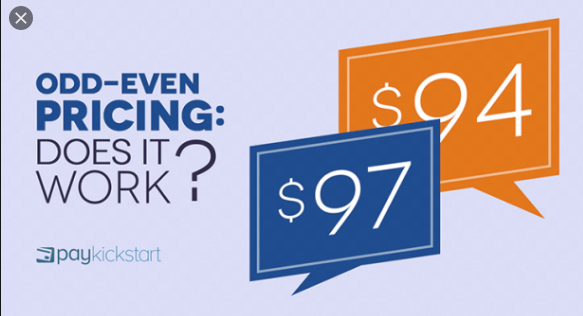Odd-Even pricing happens to be one of the simple formats that can be used in increasing sales. It is a strategy based on human psychology, which tries to decode how the human mind works.
Businesses that use odd-even pricing avoid whole numbers like $200 and instead use prices like $100.95 or $100.99.
Note that there is only a 5 cent difference between $200 and $100.95 and a penny difference for $100.99.
Odd-Even Pricing is it that Important?
According to various studies, odd-even pricing can work, even though it is not advisable to use this pricing policy every time. Thus knowing that pricing can have a huge impact on perception, and the prices you set will go a long way towards determining how customers will view your brand, it is advisable that you create a balance and know when or when not to use odd-even pricing. Thus as a business owner, you have to ensure that your prices match your goals and brand.
Note also that, pricing strategy is far more complex than simply determining if you want to use odd or even prices. Price optimization can have a huge impact on your sales and revenues.
Advantages of Odd-Even Pricing
Here are some of the advantages that come with odd-even pricing:
- It motivates impulse buying because it encourages people to purchase without thinking. This is because odd pricing often resonates with customers a discount, thus when customers see the odd numbers they may not really bother to figure out the overall cost.
- It encourages larger purchases because customers feel they are getting a discounted price. With this in mind, customers are likely to buy more.
- Also, ending your prices with odd numbers makes it difficult for people to readily add up the total cost. This will motivate people to estimate and purchase more.
Disadvantages of Odd-Even Pricing
- Odd-even pricing may cause customers to have an incorrect perception of value. This is because by ending prices in odd numbers, customers may mistake you as a discount retailer or if on the other hand, you decide to discount in even numbers, they perceive you as luxurious. Now you can prevent this as you carefully choose the price that fits the value of your product.
- It might damage LTV and perception because customers who are purchasing because they see the product as a deal are not suitable for LTV and retention. Most likely, these customers are one-time buyers and only purchase because of the perceived discount. Howbeit, if you are in retail or another industry that thrives off one-time sales, then this does not apply.
Should you always use Odd-Even Pricing?
You may not always have to use odd-even pricing. This is because a price that ends in a whole number may signify that you are confident in the value of your product and that you are a premium brand. Many premium companies are known to actually eschew odd-even pricing and sales as it could damage the prestige of their brand.
Industries that Commonly Use Odd-Even Pricing
There are some common industries that take advantage of the odd-even strategy in order to lure customers to buy their products.
Retail
Most retail stores employ an odd-even pricing strategy, sometimes all year round and sometimes during a promotion period.
Restaurants
Most family-style, chain restaurant uses the odd-even pricing. Most of them advertise a 3-course meal for only $9.99. Now, their target here is luring families who are looking for affordable meals, and by ending prices in an odd number, it is perceived as cheaper.
Also, high-end restaurants would never advertise a deal using an odd number and would never offer a three-course meal for less than $10.


